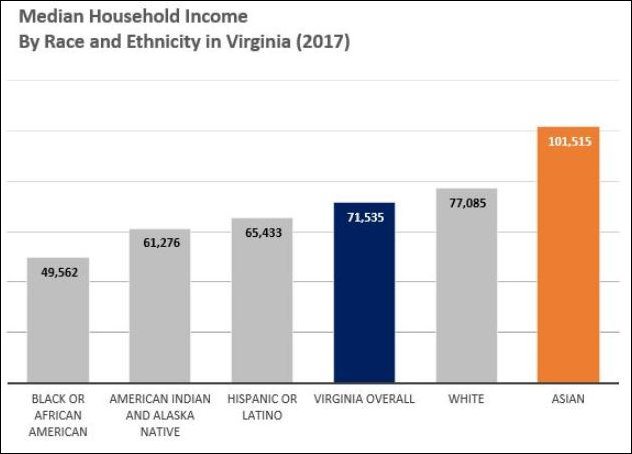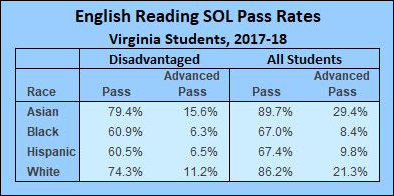
Once the victims of discrimination, Asians now are prospering in the United States. The median income in 2017 for Asians in the United States was $83,500. That compared to a national average of $60,300 — a 38% differential.
In Virginia, Asians’ incomes, and the income gap with other Americans, was even greater: $101,500 compared to $71,500, a 42% differential. Indeed, Virginia is the state with the second highest average median household income for Asians, second only to New Jersey.
Why do Asians out-perform other racial and ethnic groups? One reason is that they cluster in urban areas, where wage levels are higher. You don’t see many Asian farmers or mill workers in the United States. (When I lived in Martinsville nearly 40 years ago, I knew a Korean textile mill foreman, a former bodyguard of a South Korean dictator, who had been exiled for some reason that I can no longer remember. But his family was the only Korean household in town.)
Another reason, according to the StatChat blog, published by the Demographics Research Group at the University of Virginia, is that Asians are represented disproportionately in high-paying STEM-H occupations such as health care; architecture & engineering; life, physical and social science; and computer & mathematical.
Virginia’s Asians are a highly diverse group encompassing Chinese, Japanese, Koreans, Filipinos, Vietnamese, Indians and Pakistanis, so we have to be careful with generalization. One thing all of these groups share, however, is strong, intact families that uphold the institution of marriage and insulate children from the corrosive temptations of popular culture. Generally speaking, Asian kids work harder at school, they are more likely to succeed academically, they are more likely to attend and complete college, and they are more likely to choose academically challenging career paths that lead to higher-paying jobs. Oh, and when the IRS calculates income, Asians are more likely to belong to two-income households.
The emphasis on academic achievement can be seen in comparisons of Standards of Learning test scores.
Not only do Asian students out-perform all other ethnic groups, including whites, disadvantaged Asian students out-performed their disadvantaged peers in other ethnic groups. Remarkably, disadvantaged Asian students out-performed all blacks and Hispanics. Some of the disparity in academic achievement may be attributable to the fact that academic performance is correlated with income and that Asian students belong to higher-income households. But the achievements of disadvantaged Asian students demonstrates something else is going on.
That something, I would argue, is a familial culture that values intact family structures, academic achievement, self-discipline, and a propensity to defer gratification. Singapore Asians may be “crazy,” to riff off the title of the popular movie, “Crazy Rich Asians,” but American Asians are anything but. More than any other group, Asians embody the virtues that made this country great. That’s why they have engendered so little ethnic animosity in contemporary society, and almost all Americans are happy to see them succeed.


Leave a Reply
You must be logged in to post a comment.